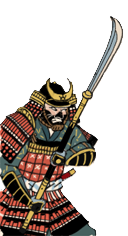
Basic Unit Statistics (can be modified by difficulty level, arts, skills, traits and retainers)
| Recruitment Cost | 750 | |
| Upkeep Cost | 150 | |
| Melee Attack | 9 | 25% |
| Charge Bonus | 12 | 24% |
| Bonus vs Cavalry | 15 | 50% |
| Melee Defence | 6 | 17% |
| Armour | 9 | 60% |
| Morale | 10 | 20% |
Strengths & Weaknesses
- Versatile infantry, good against cavalry and other infantry.
- Excellent armour makes them very resistant to arrows.
- Weak against matchlocks.
- Not as strong as more specialised anti-infantry and anti-cavalry units.
Requires
Description
These samurai are armed with long-bladed naginata. Polearms have a very effective reach in melee fighting.
The naginata is a long staff with a curved blade fixed to the end. Its length and flexibility of use make it a great melee weapon. Like all samurai, these warriors have trained hard to achieve full mastery of their chosen weapon and excel when fighting enemy cavalry and infantry. Despite their versatility, they are still vulnerable to the very best cavalry and infantry and they have little protection against missile attacks. Historically, the naginata proved to be a very adaptable weapon, used by a variety of different groups in many ways. Samurai women were trained to use it in self-defence when their men were away at war, where the polearm's length compensated for the height disparity between men and women. The sohei warrior monks used it en masse, which suited their mob-like formations, while samurai used it both when mounted and on foot. To extend its already formidable reach, a samurai would hold the end of his naginata and whirl it above his head, or stand up in the stirrups of their horses and use slashing motions at the enemy.